Analysis of Decadal Land Use Changes and Its Impacts on Urban Heat Island (UHI) Using Remote Sensing-Based Approach: A Smart City Perspective
Abstract
1. Introduction
2. Study Area
3. Data and Methodology
3.1. Satellite Data Pre-Processing
3.2. LULC Extraction and Change Analysis
3.3. Derivation of Spectral Indices
3.4. Retrieval of Land Surface Temperature (LST) Using Plank Inversion Model
3.5. Urban Heat Island Index (UHIindex)
4. Results
4.1. LULC Classification
4.2. Decadal LULC Change Analysis
4.3. Spatio-Temporal Distribution of LST during Summer and Winter
- Summer: It has been noticed that the LST ranges over the city have risen from 21–36 °C to 26–42 °C in two decades. The highest LST values are observed over built-up areas and bare lands. More specifically, the highest LST is identified over the industrial area and barren land on the city’s borders. In comparison, lower LST values are observed in vegetated areas.
- Winter: The LST ranges have also risen during the winter season from 13–22 °C in 2000 to 17–28 °C in 2020. During the winter season, a similar LST distribution pattern to the summer season is observed with the difference in LST values.
4.4. LST Distribution Pattern for Different LULC Classes
4.5. Differentiation of Built-Up (BU) Area and Barren Land (BL) Using DBSI, DBI, and EBBI
4.6. Seasonal Variation of Remote Sensing Indices through Correlation Study
4.7. Relationship between NDVI and Land Surface Temperature
4.8. Relationship between Land Surface Temperature and EBBI
4.9. Relationship between DBI, DBSI, and LST
4.10. Identification of Urban Heat Island Index (UHIindex)
4.11. Average UHIindex over 20 Years
5. Discussion
6. Conclusions
Author Contributions
Funding
Institutional Review Board Statement
Informed Consent Statement
Data Availability Statement
Acknowledgments
Conflicts of Interest
References
- Wan, Z.; Dozier, J. A generalized split-window algorithm for retrieving land-surface temperature from space. IEEE Trans. Geosci. Remote Sens. 1996, 34, 892–905. [Google Scholar]
- Gillespie, A.; Rokugawa, S.; Matsunaga, T.; Cothern, J.S.; Hook, S.; Kahle, A.B. A temperature and emissivity separation algorithm for Advanced Spaceborne Thermal Emission and Reflection Radiometer (ASTER) images. IEEE Trans. Geosci. Remote Sens. 1998, 36, 1113–1126. [Google Scholar] [CrossRef]
- Lakshmi, V.; Czajkowski, K.; Dubayah, R.; Susskind, J. Land surface air temperature mapping using TOVS and AVHRR. Int. J. Remote Sens. 2001, 22, 643–662. [Google Scholar] [CrossRef]
- Qin, Z.; Karnieli, A.; Berliner, P. A mono-window algorithm for retrieving land surface temperature from Landsat TM data and its application to the Israel-Egypt border region. Int. J. Remote Sens. 2001, 22, 3719–3746. [Google Scholar] [CrossRef]
- Aumann, H.H.; Chahine, M.T.; Gautier, C.; Goldberg, M.D.; Kalnay, E.; McMillin, L.M.; Revercomb, H.; Rosenkranz, P.W.; Smith, W.L.; Staelin, D.H.; et al. AIRS/AMSU/HSB on the Aqua mission: Design, science objectives, data products, and processing systems. IEEE Trans. Geosci. Remote Sens. 2003, 41, 253–264. [Google Scholar] [CrossRef]
- Ji, Z.; Jing, L.; Xiang, Z.; Wen-Feng, Z.; Jian-Xia, G. A modified single-channel algorithm for land surface temperature retrieval from HJ-1B satellite data. J. Infrared Millim. Waves 2011, 30, 61–67. [Google Scholar]
- Zhou, J.; Li, J.; Zhang, L.; Hu, D.; Zhan, W. Intercomparison of methods for estimating land surface temperature from a Landsat-5 TM image in an arid region with low water vapour in the atmosphere. Int. J. Remote Sens. 2012, 33, 2582–2602. [Google Scholar] [CrossRef]
- Liu, W.; Feddema, J.; Hu, L.; Zung, A.; Brunsell, N. Seasonal and diurnal characteristics of land surface temperature and major explanatory factors in Harris County, Texas. Sustainability 2017, 9, 2324. [Google Scholar] [CrossRef]
- Oke, T.R. City size and the urban heat island. Atmos. Environ. 1973, 7, 769–779. [Google Scholar] [CrossRef]
- Voogt, J.A.; Oke, T.R. Thermal remote sensing of urban climates. Remote Sens. Environ. 2003, 86, 370–384. [Google Scholar] [CrossRef]
- Voogt, J.A. Urban Heat Islands: Hotter Cities; ActionBioscience: Herndon, VA, USA, 2012. [Google Scholar]
- Rotach, M.W.; Vogt, R.; Bernhofer, C.; Batchvarova, E.; Christen, A.; Clappier, A.; Feddersen, B.; Gryning, S.E.; Martucci, G.; Mayer, H.; et al. BUBBLE–an urban boundary layer meteorology project. Theor. Appl. Climatol. 2005, 81, 231–261. [Google Scholar] [CrossRef]
- Roth, M. -Urban Heat Islands. In Handbook of Environmental Fluid Dynamics; CRC Press: Boca Raton, FL, USA, 2012; Volume 2, pp. 162–168. [Google Scholar]
- Pal, S.; Ziaul, S.K. Detection of land use and land cover change and land surface temperature in English Bazar urban centre. Egypt. J. Remote Sens. Space Sci. 2017, 20, 125–145. [Google Scholar] [CrossRef]
- Patel, P.; Thakur, P.K.; Aggarwal, S.P.; Garg, V.; Dhote, P.R.; Nikam, B.R.; Swain, S.; Al-Ansari, N. Revisiting 2013 Uttarakhand flash floods through hydrological evaluation of precipitation data sources and morphometric prioritization. Geomat. Nat. Hazards Risk 2022, 13, 646–666. [Google Scholar] [CrossRef]
- Swain, S.; Mishra, S.K.; Pandey, A.; Pandey, A.C.; Jain, A.; Chauhan, S.K.; Badoni, A.K. Hydrological modelling through SWAT over a Himalayan catchment using high-resolution geospatial inputs. Environ. Chall. 2022, 8, 100579. [Google Scholar] [CrossRef]
- Das, P.; Mudi, S.; Behera, M.D.; Barik, S.K.; Mishra, D.R.; Roy, P.S. Automated mapping for long-term analysis of shifting cultivation in Northeast India. Remote Sens. 2021, 13, 1066. [Google Scholar] [CrossRef]
- Swain, S.; Mishra, S.K.; Pandey, A.; Dayal, D. Spatiotemporal assessment of precipitation variability, seasonality, and extreme characteristics over a Himalayan catchment. Theor. Appl. Climatol. 2022, 147, 817–833. [Google Scholar] [CrossRef]
- Behera, M.D.; Gupta, A.K.; Barik, S.K.; Das, P.; Panda, R.M. Use of satellite remote sensing as a monitoring tool for land and water resources development activities in an Indian tropical site. Environ. Monit. Assess. 2018, 190, 401. [Google Scholar] [CrossRef]
- Swain, S.; Mishra, S.K.; Pandey, A.; Kalura, P. Inclusion of groundwater and socio-economic factors for assessing comprehensive drought vulnerability over Narmada River Basin, India: A geospatial approach. Appl. Water Sci. 2022, 12, 14. [Google Scholar] [CrossRef]
- Singh, K.V.; Setia, R.; Sahoo, S.; Prasad, A.; Pateriya, B. Evaluation of NDWI and MNDWI for assessment of waterlogging by integrating digital elevation model and groundwater level. Geocarto Int. 2015, 30, 650–661. [Google Scholar] [CrossRef]
- Gupta, A.; Himanshu, S.K.; Gupta, S.; Singh, R. Evaluation of the SWAT model for analyzing the water balance components for the upper Sabarmati Basin. Adv. Water Resour. Eng. Manag. 2020, 39, 141–151. [Google Scholar]
- Swain, S.; Taloor, A.K.; Dhal, L.; Sahoo, S.; Al-Ansari, N. Impact of climate change on groundwater hydrology: A comprehensive review and current status of the Indian hydrogeology. Appl. Water Sci. 2022, 12, 120. [Google Scholar] [CrossRef]
- Himanshu, S.K.; Pandey, A.; Yadav, B. Assessing the applicability of TMPA-3B42V7 precipitation dataset in wavelet-support vector machine approach for suspended sediment load prediction. J. Hydrol. 2017, 550, 103–117. [Google Scholar] [CrossRef]
- Aadhar, S.; Swain, S.; Rath, D.R. Application and performance assessment of SWAT hydrological model over Kharun river basin, Chhattisgarh, India. In ASCE World Environmental and Water Resources Congress 2019: Watershed Management, Irrigation and Drainage, and Water Resources Planning and Management; American Society of Civil Engineers: Reston, VA, USA, 2019; pp. 272–280. [Google Scholar]
- Himanshu, S.K.; Pandey, A.; Patil, A. Hydrologic evaluation of the TMPA-3B42V7 precipitation data set over an agricultural watershed using the SWAT model. J. Hydrol. Eng. 2018, 23, 05018003. [Google Scholar] [CrossRef]
- Palmate, S.S.; Amrit, K.; Jadhao, V.G.; Dayal, D.; Himanshu, S.K. Prioritization of erosion prone areas based on a sediment yield index for conservation treatments: A case study of the upper Tapi River basin. In Advances in Remediation Techniques for Polluted Soils and Groundwater; Elsevier: Amsterdam, The Netherlands, 2021; pp. 291–307. [Google Scholar]
- Himanshu, S.K.; Pandey, A.; Dayal, D. Evaluation of satellite-based precipitation estimates over an agricultural watershed of India. In ASCE World Environmental and Water Resources Congress 2018: Watershed Management, Irrigation and Drainage, and Water Resources Planning and Management; American Society of Civil Engineers: Reston, VA, USA, 2018; pp. 308–320. [Google Scholar]
- Swain, S.; Sahoo, S.; Taloor, A.K.; Mishra, S.K.; Pandey, A. Exploring recent groundwater level changes using Innovative Trend Analysis (ITA) technique over three districts of Jharkhand, India. Groundw. Sustain. Dev. 2022, 18, 100783. [Google Scholar] [CrossRef]
- Sahoo, S.; Swain, S.; Goswami, A.; Sharma, R.; Pateriya, B. Assessment of trends and multi-decadal changes in groundwater level in parts of the Malwa region, Punjab, India. Groundw. Sustain. Dev. 2021, 14, 100644. [Google Scholar] [CrossRef]
- Behera, M.D.; Murthy, M.S.R.; Das, P.; Sharma, E. Modelling forest resilience in Hindu Kush Himalaya using geoinformation. J. Earth Syst. Sci. 2018, 127, 95. [Google Scholar] [CrossRef]
- Das, P.; Behera, M.D.; Murthy, M.S.R. Forest fragmentation and human population varies logarithmically along elevation gradient in Hindu Kush Himalaya-utility of geospatial tools and free data set. J. Mt. Sci. 2017, 14, 2432–2447. [Google Scholar] [CrossRef]
- Swain, S.; Sahoo, S.; Taloor, A.K. Groundwater quality assessment using geospatial and statistical approaches over Faridabad and Gurgaon districts of National Capital Region, India. Appl. Water Sci. 2022, 12, 75. [Google Scholar] [CrossRef]
- Das, P.; Behera, M.D.; Pal, S.; Chowdary, V.M.; Behera, P.R.; Singh, T.P. Studying land use dynamics using decadal satellite images and Dyna-CLUE model in the Mahanadi River basin, India. Environ. Monit. Assess. 2019, 191, 804. [Google Scholar] [CrossRef]
- Guptha, G.C.; Swain, S.; Al-Ansari, N.; Taloor, A.K.; Dayal, D. Assessing the role of SuDS in resilience enhancement of urban drainage system: A case study of Gurugram City, India. Urban Clim. 2022, 41, 101075. [Google Scholar] [CrossRef]
- Yadav, B.; Gupta, P.K.; Patidar, N.; Himanshu, S.K. Ensemble modelling framework for groundwater level prediction in urban areas of India. Sci. Total Environ. 2020, 712, 135539. [Google Scholar] [CrossRef] [PubMed]
- Guptha, G.C.; Swain, S.; Al-Ansari, N.; Taloor, A.K.; Dayal, D. Evaluation of an urban drainage system and its resilience using remote sensing and GIS. Remote Sens. Appl. Soc. Environ. 2021, 23, 100601. [Google Scholar]
- Lwasa, S.; Mugagga, F.; Wahab, B.; Simon, D.; Connors, J.; Griffith, C. Urban and peri-urban agriculture and forestry: Transcending poverty alleviation to climate change mitigation and adaptation. Urban Clim. 2014, 7, 92–106. [Google Scholar] [CrossRef]
- Li, Z.L.; Tang, B.H.; Wu, H.; Ren, H.; Yan, G.; Wan, Z.; Trigo, I.F.; Sobrino, J.A. Satellite-derived land surface temperature: Current status and perspectives. Remote Sens. Environ. 2013, 131, 14–37. [Google Scholar] [CrossRef]
- Morabito, M.; Crisci, A.; Messeri, A.; Orlandini, S.; Raschi, A.; Maracchi, G.; Munafò, M. The impact of built-up surfaces on land surface temperatures in Italian urban areas. Sci. Total Environ. 2016, 551, 317–326. [Google Scholar] [CrossRef] [PubMed]
- Surawar, M.; Kotharkar, R. Assessment of urban heat island through remote sensing in Nagpur urban area using landsat 7 ETM+ Satellite Images. Int. J. Urban Civil Eng. 2017, 11, 868–874. [Google Scholar]
- Mukherjee, S.; Joshi, P.K.; Garg, R.D. Analysis of urban built-up areas and surface urban heat island using downscaled MODIS derived land surface temperature data. Geocarto Int. 2017, 32, 900–918. [Google Scholar] [CrossRef]
- Zheng, Y.; Ren, H.; Guo, J.; Ghent, D.; Tansey, K.; Hu, X.; Nie, J.; Chen, S. Land surface temperature retrieval from sentinel-3A sea and land surface temperature radiometer, using a split-window algorithm. Remote Sens. 2019, 11, 650. [Google Scholar] [CrossRef]
- Kafy, A.A.; Islam, M.; Sikdar, S.; Ashrafi, T.J.; Al-Faisal, A.; Islam, M.A.; Al Rakib, A.; Khan, M.H.H.; Sarker, M.H.S.; Ali, M.Y. Remote sensing-based approach to identify the influence of land use/land cover change on the urban thermal environment: A case study in Chattogram City, Bangladesh. In Re-Envisioning Remote Sensing Applications; CRC Press: Boca Raton, FL, USA, 2021; pp. 217–240. [Google Scholar]
- Rasool, R.; Fayaz, A.; ul Shafiq, M.; Singh, H.; Ahmed, P. Land use land cover change in Kashmir Himalaya: Linking remote sensing with an indicator based DPSIR approach. Ecol. Indic. 2021, 125, 107447. [Google Scholar] [CrossRef]
- Ramaiah, M.; Avtar, R.; Rahman, M.M. Land Cover Influences on LST in Two Proposed Smart Cities of India: Comparative Analysis Using Spectral Indices. Land 2020, 9, 292. [Google Scholar] [CrossRef]
- Polydoros, A.; Mavrakou, T.; Cartalis, C. Quantifying the Trends in Land Surface Temperature and Surface Urban Heat Island Intensity in Mediterranean Cities in View of Smart Urbanization. Urban Sci. 2018, 2, 16. [Google Scholar]
- Nimish, G.; Chandan, M.C.; Bharath, H.A. Understanding current and future landuse dynamics with land surface temperature alterations: A case study of Chandigarh. ISPRS Ann. Photogramm. Remote Sens. Spat. Inf. Sci. 2018, 4, 79–86. [Google Scholar] [CrossRef]
- Gupta, N.; Mathew, A.; Khandelwal, S. Analysis of cooling effect of water bodies on land surface temperature in nearby region: A case study of Ahmedabad and Chandigarh cities in India. Egypt. J. Remote Sens. Space Sci. 2019, 22, 81–93. [Google Scholar] [CrossRef]
- Mathew, A.; Sreekumar, S.; Khandelwal, S.; Kumar, R. Prediction of land surface temperatures for surface urban heat island assessment over Chandigarh city using support vector regression model. Sol. Energy 2019, 186, 404–415. [Google Scholar] [CrossRef]
- Sultana, S.; Satyanarayana, A.N.V. Urban heat island intensity during winter over metropolitan cities of India using remote-sensing techniques: Impact of urbanization. Int. J. Remote Sens. 2018, 39, 6692–6730. [Google Scholar] [CrossRef]
- Majumder, A.; Setia, R.; Kingra, P.K.; Sembhi, H.; Singh, S.P.; Pateriya, B. Estimation of land surface temperature using different retrieval methods for studying the spatiotemporal variations of surface urban heat and cold islands in Indian Punjab. Environ. Dev. Sustain. 2021, 23, 15921–15942. [Google Scholar] [CrossRef]
- Li, H.; Wang, C.; Zhong, C.; Su, A.; Xiong, C.; Wang, J.; Liu, J. Mapping Urban Bare Land Automatically from Landsat Imagery with a Simple Index. Remote Sens. 2017, 9, 249. [Google Scholar]
- Rasul, A.; Balzter, H.; Ibrahim, G.R.F.; Hameed, H.M.; Wheeler, J.; Adamu, B. Applying Built-Up and Bare-Soil Indices fromLandsat 8 to Cities in Dry Climates. Land 2018, 7, 81. [Google Scholar] [CrossRef]
- Chen, X.L.; Zhao, H.M.; Li, P.X.; Yin, Z.Y. Remote sensing image-based analysis of the relationship between urban heat island and land use/cover changes. Remote Sens. Environ. 2006, 104, 133–146. [Google Scholar] [CrossRef]
- Pan, J. Area delineation and spatial-temporal dynamics of urban heat island in Lanzhou City, China using remote sensing imagery. J. Indian Soc. Remote Sens. 2016, 44, 111–127. [Google Scholar] [CrossRef]
- Sobrino, J.A.; Jiménez-Muñoz, J.C.; Labed-Nachbrand, J.; Nerry, F. Surface emissivity retrieval from digital airborne imaging spectrometer data. J. Geophys. Res. Atmos. 2002, 107, ACL 24-1–ACL 24-13. [Google Scholar] [CrossRef]
- Jiménez-Muñoz, J.C.; Sobrino, J.A.; Gillespie, A.; Sabol, D.; Gustafson, W.T. Improved land surface emissivities over agricultural areas using ASTER NDVI. Remote Sens. Environ. 2006, 103, 474–487. [Google Scholar] [CrossRef]
- Mathew, A.; Khandelwal, S.; Kaul, N. Spatial and temporal variations of urban heat island effect and the effect of percentage impervious surface area and elevation on land surface temperature: Study of Chandigarh city, India. Sustain. Cities Soc. 2016, 26, 264–277. [Google Scholar] [CrossRef]
- IPCC. Climate Change 2021-the Physical Science Basis, Contribution of Working Group I to the Sixth Assessment Report of the Intergovernmental Panel on Climate Change; Masson-Delmotte, V., Zhai, P., Pirani, A., Connors, S.L., Péan, C., Berger, S., Caud, N., Chen, Y., Goldfarb, L., Gomis, M.I., et al., Eds.; Cambridge University Press: Cambridge, UK, 2021. [Google Scholar]
- Nandi, S.; Swain, S. Analysis of heatwave characteristics under climate change over three highly populated cities of South India: A CMIP6-based assessment. Environ. Sci. Pollut. Res. 2022, 1–13. [Google Scholar] [CrossRef] [PubMed]
- Abutaleb, K.; Ngie, A.; Darwish, A.; Ahmed, M.; Arafat, S.; Ahmed, F. Assessment of urban heat island using remotely sensed imagery over Greater Cairo, Egypt. Adv. Remote Sens. 2015, 4, 35. [Google Scholar] [CrossRef]
- Bokaie, M.; Zarkesh, M.K.; Arasteh, P.D.; Hosseini, A. Assessment of urban heat island based on the relationship between land surface temperature and land use/land cover in Tehran. Sustain. Cities Soc. 2016, 23, 94–104. [Google Scholar] [CrossRef]
- Mallick, J.; Kant, Y.; Bharath, B.D. Estimation of land surface temperature over Delhi using Landsat-7 ETM+. J. Indian Geophys. Union 2008, 12, 131–140. [Google Scholar]
- Naserikia, M.; Asadi Shamsabadi, E.; Rafieian, M.; Leal Filho, W. The urban heat island in an urban context: A case study of Mashhad, Iran. Int. J. Environ. Res. Public Health 2019, 16, 313. [Google Scholar] [CrossRef]
- Balasubramanian, K.; Segarin, S.; Narayanan, P.; Das, P. Opportunities for Improving Urban Tree Cover: A Case Study in Kochi. In Blue-Green Infrastructure Across Asian Countries; Springer: Singapore, 2022; pp. 251–270. [Google Scholar]



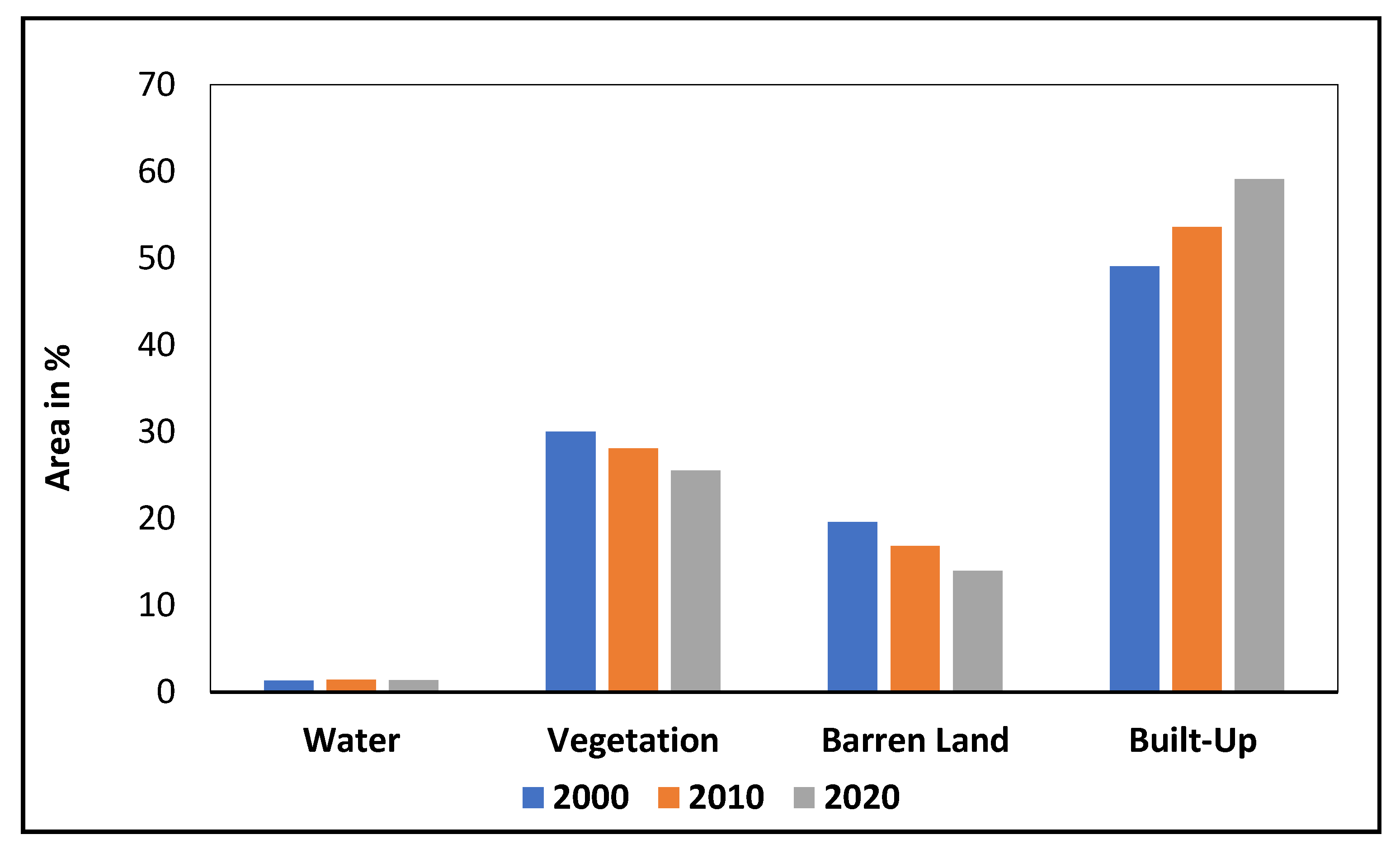


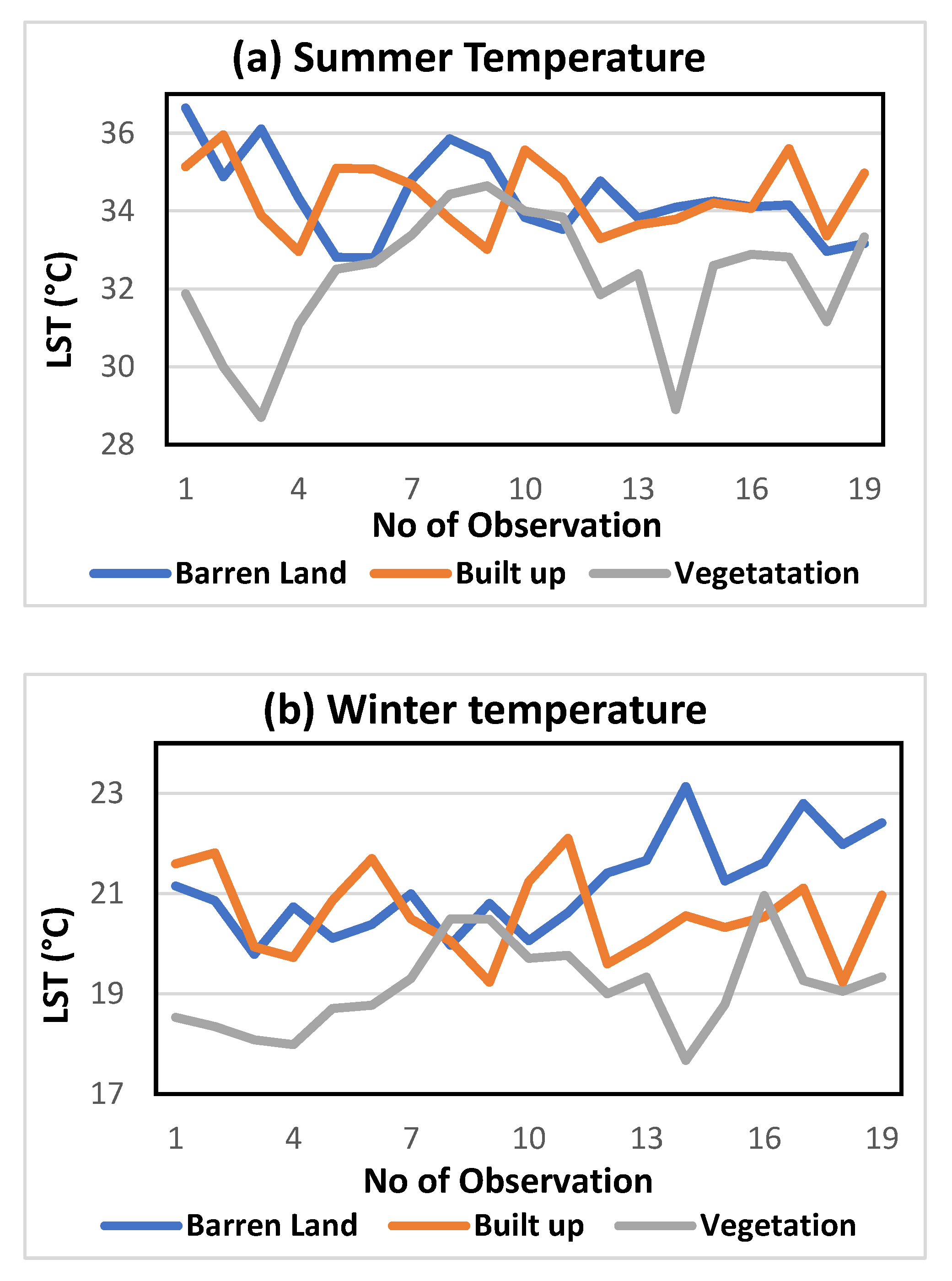

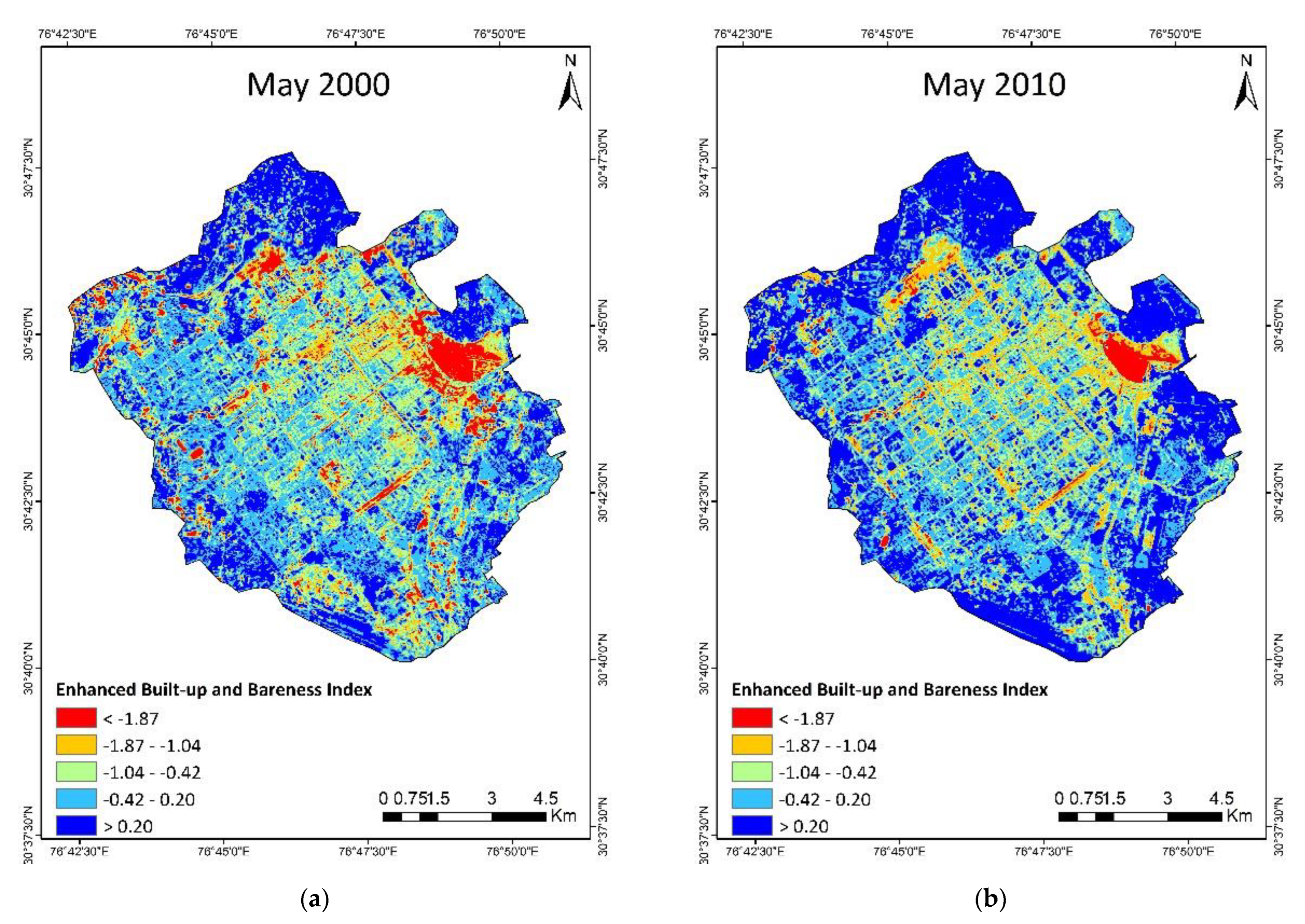
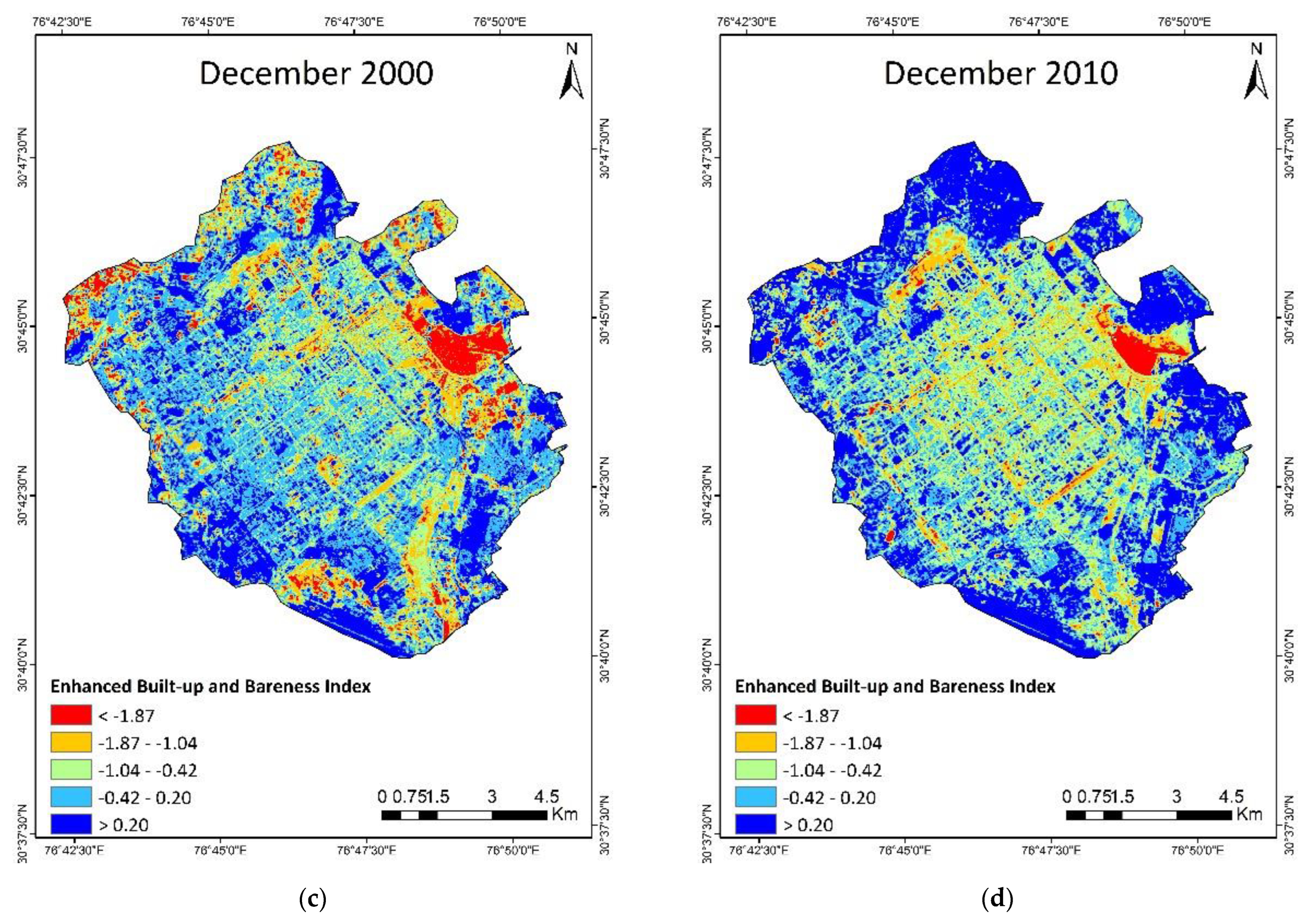
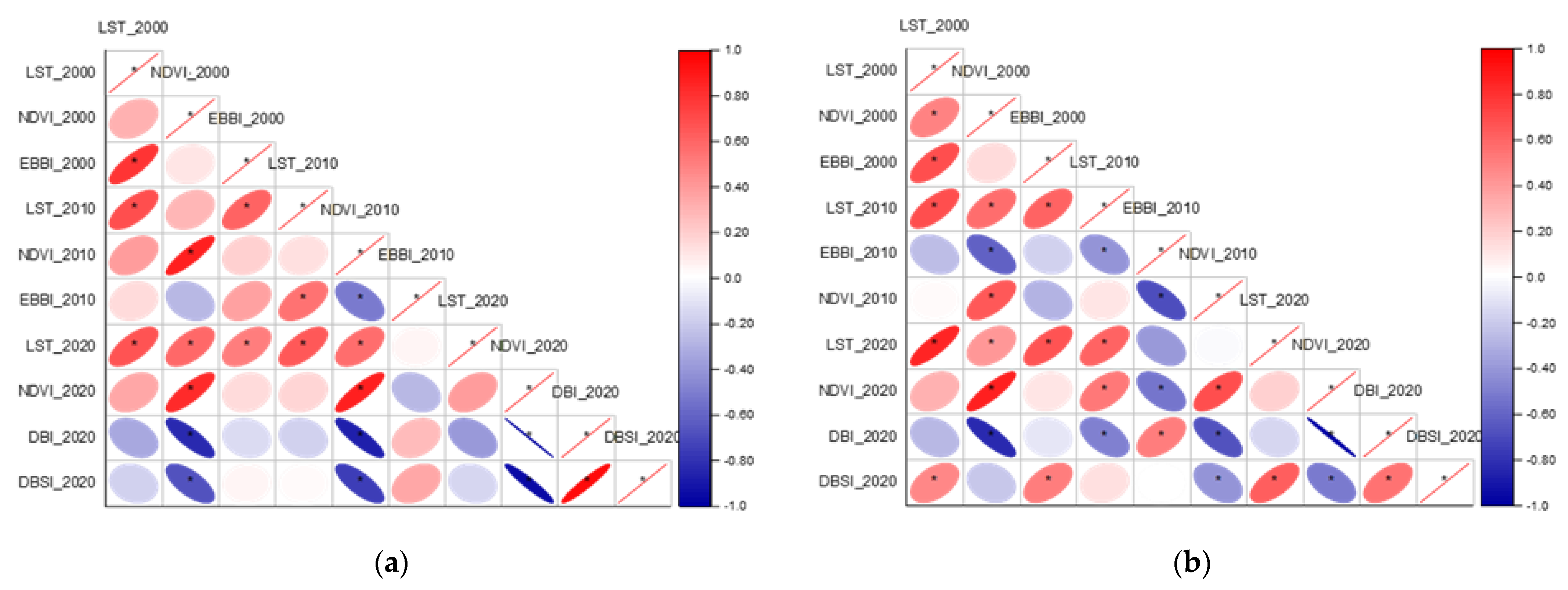
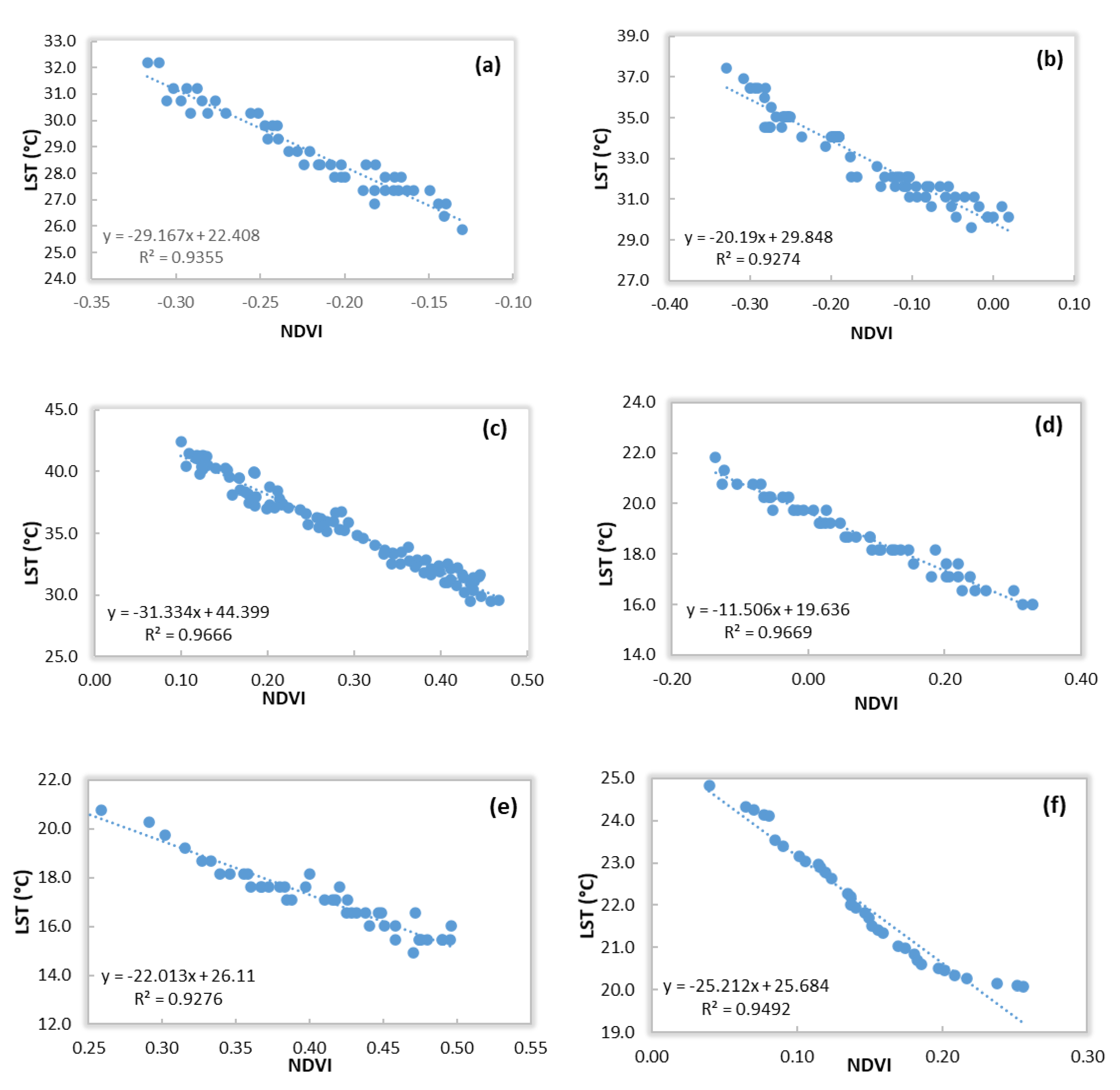



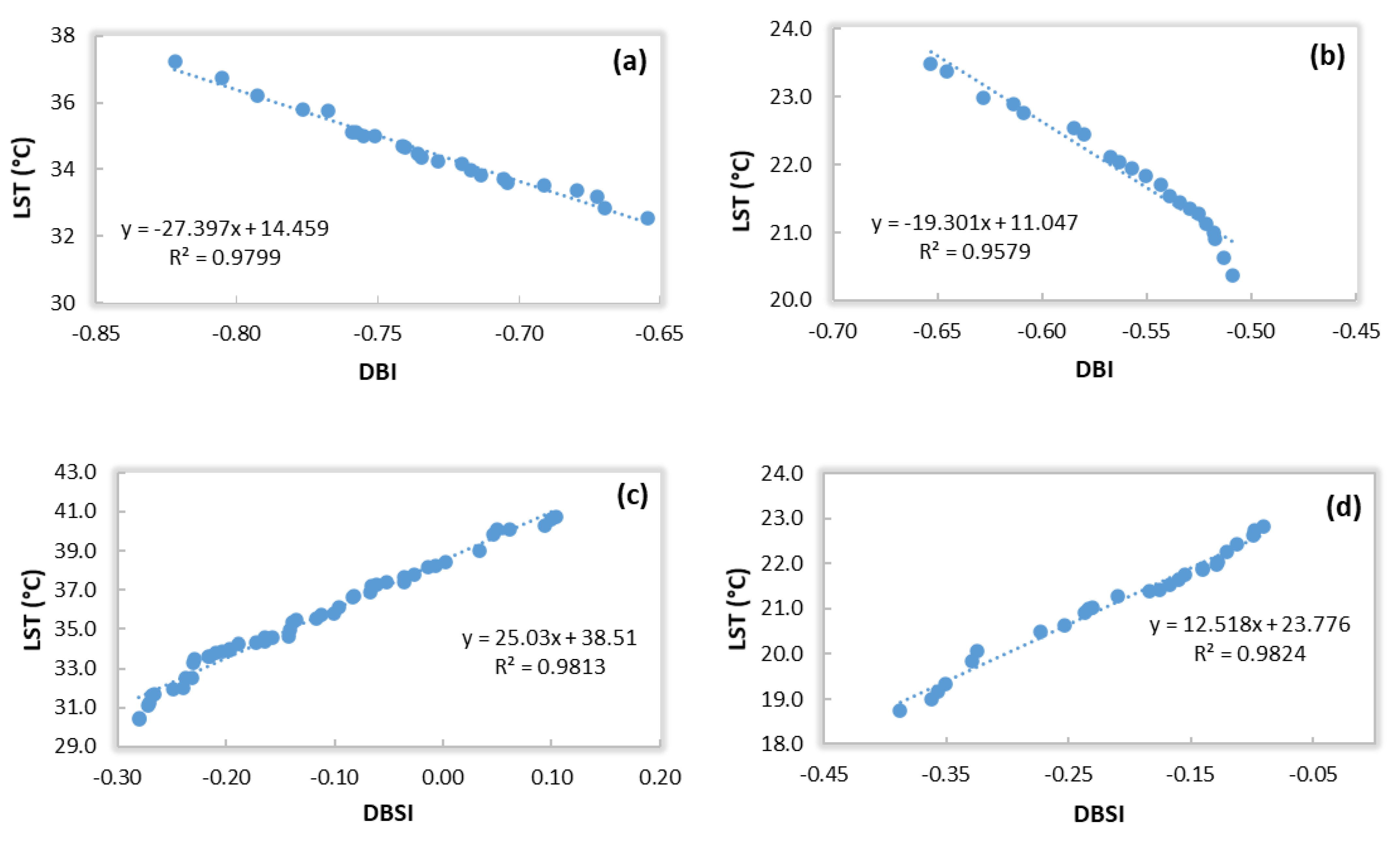
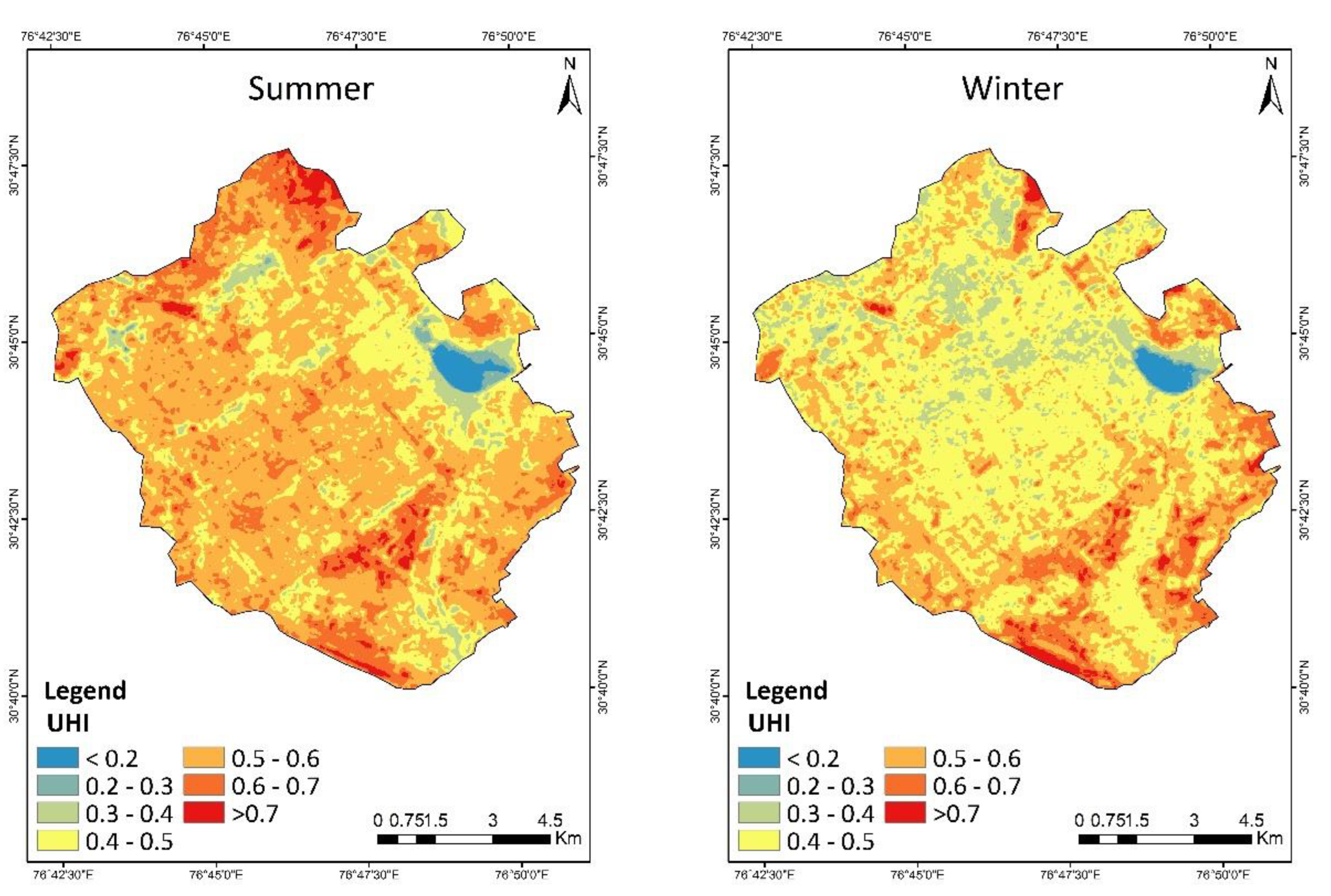
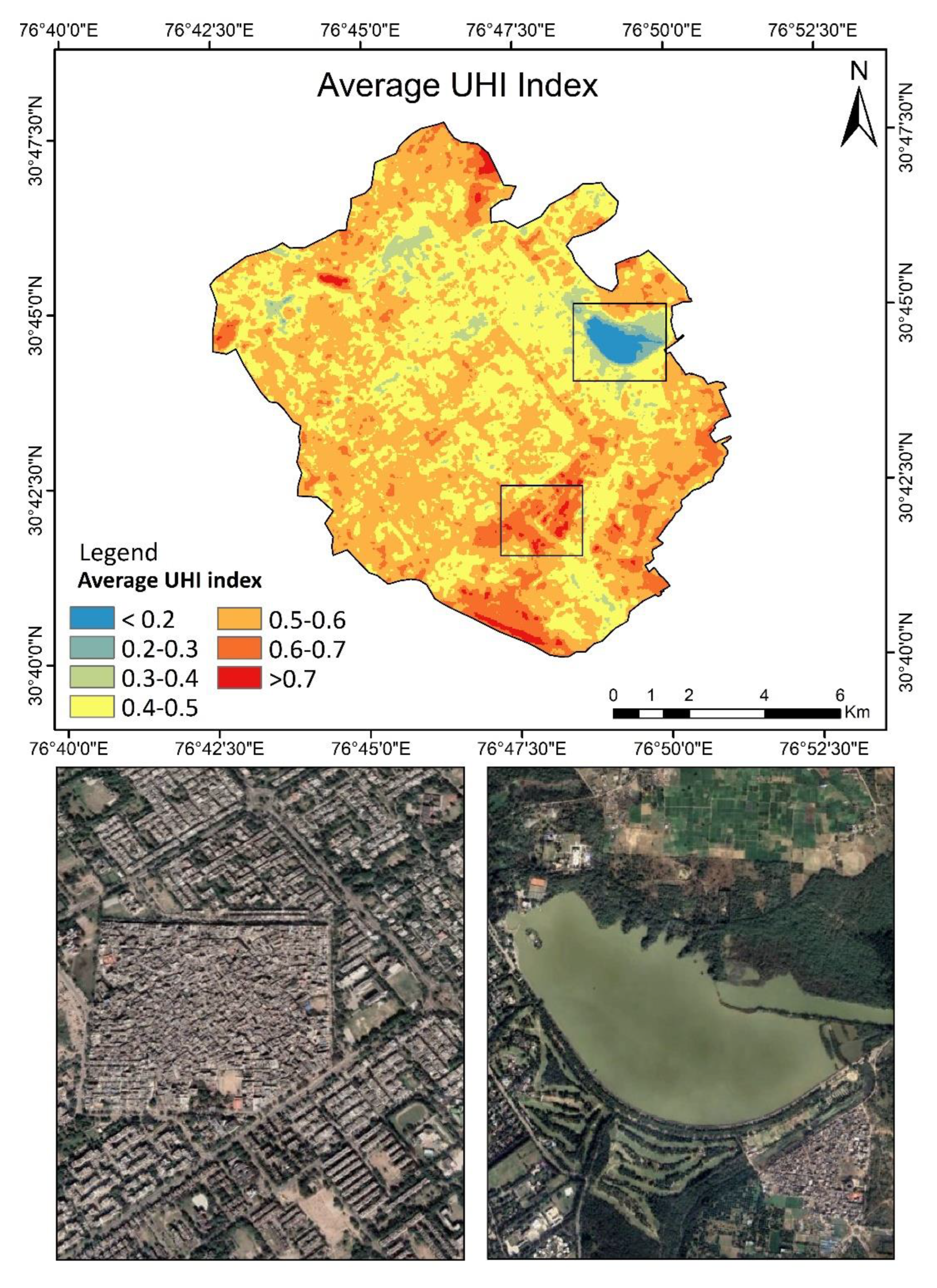
| Seasons | Year | Satellite | Date of Acquisition |
|---|---|---|---|
| 2000 | Landsat 7 | 8 May 2000 | |
| Summer | 2010 | Landsat 7 | 4 May 2010 |
| 2020 | Landsat 8 | 7 May 2020 | |
| 2000 | Landsat 7 | 18 December 2000 | |
| Winter | 2010 | Landsat 7 | 14 December 2010 |
| 2020 | Landsat 8 | 1 December 2020 |
| Seasons | Formula for Landsat 7 | Formula for Landsat 8 |
|---|---|---|
| NDVI | (B4 − B3)/(B4 + B3) | (B5 − B4)/(B5 + B4) |
| EBBI | - | |
| DBI | - | [(B2 − B10)/(B2 + B10)] − NDVI |
| DBSI | - | [(B6 − B3)/(B6 + B3)] − NDVI |
| Year | Overall Accuracy | Kappa Coefficient |
|---|---|---|
| 2000 | 84.00% | 0.7670 |
| 2010 | 82.00% | 0.7397 |
| 2020 | 88.00% | 0.8106 |
| Year | Water | Vegetation | Barren Land | Built-Up |
|---|---|---|---|---|
| 2000 | 1.31% | 30.02% | 19.63% | 49.04% |
| 2010 | 1.43% | 28.12% | 16.87% | 53.58% |
| 2020 | 1.40% | 25.52% | 13.96% | 59.12% |
| Year | Area (%) | |
|---|---|---|
| Summer | Winter | |
| <0.2 | 1.01 | 0.90 |
| 0.2–0.3 | 0.75 | 0.37 |
| 0.3–0.4 | 3.80 | 9.31 |
| 0.4–0.5 | 21.48 | 49.98 |
| 0.5–0.6 | 55.35 | 29.00 |
| 0.6–0.7 | 15.57 | 8.92 |
| >0.7 | 1.99 | 1.48 |
Publisher’s Note: MDPI stays neutral with regard to jurisdictional claims in published maps and institutional affiliations. |
© 2022 by the authors. Licensee MDPI, Basel, Switzerland. This article is an open access article distributed under the terms and conditions of the Creative Commons Attribution (CC BY) license (https://creativecommons.org/licenses/by/4.0/).
Share and Cite
Sahoo, S.; Majumder, A.; Swain, S.; Gareema; Pateriya, B.; Al-Ansari, N. Analysis of Decadal Land Use Changes and Its Impacts on Urban Heat Island (UHI) Using Remote Sensing-Based Approach: A Smart City Perspective. Sustainability 2022, 14, 11892. https://doi.org/10.3390/su141911892
Sahoo S, Majumder A, Swain S, Gareema, Pateriya B, Al-Ansari N. Analysis of Decadal Land Use Changes and Its Impacts on Urban Heat Island (UHI) Using Remote Sensing-Based Approach: A Smart City Perspective. Sustainability. 2022; 14(19):11892. https://doi.org/10.3390/su141911892
Chicago/Turabian StyleSahoo, Sashikanta, Atin Majumder, Sabyasachi Swain, Gareema, Brijendra Pateriya, and Nadhir Al-Ansari. 2022. "Analysis of Decadal Land Use Changes and Its Impacts on Urban Heat Island (UHI) Using Remote Sensing-Based Approach: A Smart City Perspective" Sustainability 14, no. 19: 11892. https://doi.org/10.3390/su141911892
APA StyleSahoo, S., Majumder, A., Swain, S., Gareema, Pateriya, B., & Al-Ansari, N. (2022). Analysis of Decadal Land Use Changes and Its Impacts on Urban Heat Island (UHI) Using Remote Sensing-Based Approach: A Smart City Perspective. Sustainability, 14(19), 11892. https://doi.org/10.3390/su141911892











